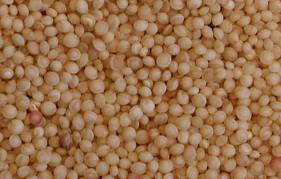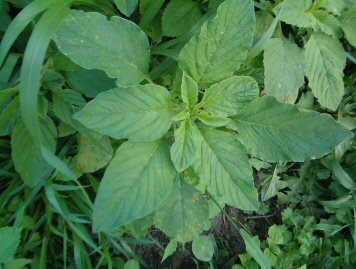Amaranth refers to a wide variety of species in the genus Amaranthus — such as green amaranth, palmer amaranth, and spiny pigweed — many of which are often referred to colloquially as pigweed. Like quinoa, amaranth seeds are considered to be a pseudocereal, and the plant’s leaves can be eaten like spinach, as well.
Amaranth has been cultivated for thousands of years. It is a nutrient-rich food that is high in protein, fiber, and minerals. The plants can be found wild throughout North America, and they are easy to identify by their leaves and flowers.
In this post, we will discuss how to forage for these “weeds,” and we will provide tips on how to harvest and store this nutritious plant. We will also provide information about the nutritional value of amaranth and some recipe ideas.
How to Identify Wild Amaranth
Amaranth can be identified by its leaves and flowers. It can grow up to six feet tall as it approaches the flowering stage of its life cycle.
The alternate, oval, diamond-shaped leaves are typically broad and blade-like, and they have a smooth texture. Sometimes the leaves are hairy, depending on the species.
Most species of amaranth have a smooth stem, though some have a hairy stem, and the stem often gets redder as the plant matures.
Amaranth Flowers
Amaranth flowers are very distinct. These small flowers come in a variety of colors, including red, orange, yellow, purple, and pink, and they grow by the hundreds on a flower spike. The flowers mature into tiny, husked seeds that become pseudocereal.
Where to Find Wild Amaranth
Many amaranth species are native to North America, and additional amaranth species have been introduced to the region. This abundant weed can be found almost anywhere, and it is often intentionally grown by farmers, too.
Amaranth plants commonly grow in disturbed areas, such as roadsides, parks, vacant lots, and agricultural fields. Wild amaranth is often found growing in the cracks of sidewalks and up the walls of buildings.
Foraging for Amaranth Seed
Amaranth seeds can be harvested from the wild and used as a grain. These pseudocereal seeds are high in protein and minerals, and they have a nutty flavor.

Some people mistakenly refer to “amaranth grain” as an “ancient grain,” but this is incorrect. The small husks are a seed and not a grain, which makes amaranth low-carb and gluten-free.
Harvesting and Preparing
The edible seeds can be harvested when the flowers on the plant have dried up and turned brown. You will notice that the seeds begin to fall around this time.
The best way to harvest amaranth seed is to cut the flower spike off the plant and put it in a paper bag. Then, shake the bag to release the seed heads, and store them in a cool, dry place until you are ready to use them.
Do not eat amaranth seed raw. These seeds can be cooked and crushed into amaranth flour, however, which can be used as a gluten-free and protein-packed alternative to any other flour. Amaranth flour can be used to make pancakes, waffles, bread, pasta, and more.
Foraging for Amaranth Leaves
Cooked amaranth leaves are mild and have a flavor and texture similar to spinach. They are both a member of the same family, Amaranthaceae.

When harvesting the leaves, aim for the smaller, younger leaves, which will be more tender, flavorful, and nutrient-dense. The larger, older leaves may be bitter and may contain fewer nutrients.
If you cut back a large portion of an amaranth plant to harvest the leaves, the plant will grow back, as long as there is still enough time in the growing season. So if you harvest amaranth leaves early, you can complete multiple harvest rounds before the season is over.
Treat the leaves like spinach or kale. You could sautee them, stir fry them, eat them in a salad, or prepare them in any other manner that you would normally prep leafy greens.
Foraging for Amaranth Stems
The stems of wild amaranth can also be eaten. They are crunchy and have a slightly sweet flavor. Harvest the stems earlier in the growing season, as they will begin to get tough as the plant begins to flower.
When harvesting the stems, cut them off close to the ground so that new growth will sprout. You can use the tender stems in the same way you would use celery or asparagus. They will be more substantial and vegetable-like than the leaves.
How to Store Wild Amaranth
Amaranth leaves can be stored in the refrigerator for up to a week, and the leaves can also be frozen. To store the leaves, wash them thoroughly, dry them completely, and then place them in an airtight container lined with a paper towel.
The stems should be stored in the same way as the leaves.
Amaranth seeds can be stored in a cool, dry place for up to six months in a jar. If you want to store them for longer, you can keep them in the freezer.
Amaranth Nutritional Information
Amaranth seeds are low in carbs and high in protein, making them a healthier substitute for white rice, pasta, and other carbs.
The leaves are packed with nutrients and have more vitamin C than spinach or kale. They also have high levels of vitamin A, potassium, and calcium.
Amaranth is also an excellent source of fiber, whether you’re eating the seeds, the leaves, or the stems.
Amaranth Recipe Ideas
Given the diversity of amaranth’s pseudocereal seeds, leaves, and stems, there are countless dishes that you can prepare.
Seeds
You could use the seeds to make amaranth porridge with honey, popped amaranth (like popcorn), or an amaranth pilaf or polenta.
If you process the seeds into amaranth flour, the possibilities are endless. Nearly anything that is prepared with flour can be made with this substitute instead.
Leaves and Stems
Beyond just sauteeing the leaves and stems with olive oil to prepare cooked greens, you could make amaranth pesto (“pigweed pesto”), amaranth onion fritters (perhaps with wild onions, since you’re already foraging), or amaranth quiche.
Amaranth and Phytoremediation: A Warning
Amaranth plants are efficient at phytoremediation, which refers to the ability of plants to absorb and remove toxins from contaminated soil. This is a terrific ability when trying to improve soil quality, but it’s not ideal for wild plants that you want to eat.
In other words, wild amaranth may have absorbed toxins from the environment in which it is growing, such as lead. These toxins could be present in the soil, water, or air.
If you are foraging for wild amaranth to eat, make sure that you are doing so in an area that is free from environmental contamination. You could even test the soil for lead and other contaminants to be safe.
FAQ About Amaranth
Q: Is amaranth safe for everyone to eat?
A: Amaranth is safe for most people to eat, but there are a few precautions that you should take. Pregnant women and those who are breastfeeding should avoid amaranth because of its high levels of calcium. Children under the age of two should also avoid it, as they may not have fully developed digestive systems that can handle the seeds.
Q: Can amaranth be grown at home?
A: Yes, you can grow amaranth at home. It’s a quick-growing plant that does well in both warm and cool climates.
Q: Are there any dangerous look-a-likes to amaranth?
A: Some confuse pellitory, which can cause allergies, for amaranth. You can tell the difference between the plants by observing the flowers. The flowers of the pellitory plant grow in between the leaves along the stem, while amaranth flowers grow in bunches at the top of flower spikes.
Some also confuse lamb’s quarters for amaranth, though this plant is also a choice edible that is safe to eat. While the leaves look similar, the flowers and seeds of the lamb’s quarters plant are ultimately less prolific.


Maine has tones of things that grow wild , when I lived there we picked several thing in the summer , it amazed me that things could make it through the winters up there , but they do .
Hello Web Admin, I noticed that your On-Page SEO is is missing a few factors, for one you do not use all three H tags in your post, also I notice that you are not using bold or italics properly in your SEO optimization. On-Page SEO means more now than ever since the new Google update: Panda. No longer are backlinks and simply pinging or sending out a RSS feed the key to getting Google PageRank or Alexa Rankings, You now NEED On-Page SEO. So what is good On-Page SEO?First your keyword must appear in the title.Then it must appear in the URL.You have to optimize your keyword and make sure that it has a nice keyword density of 3-5% in your article with relevant LSI (Latent Semantic Indexing). Then you should spread all H1,H2,H3 tags in your article.Your Keyword should appear in your first paragraph and in the last sentence of the page. You should have relevant usage of Bold and italics of your keyword.There should be one internal link to a page on your blog and you should have one image with an alt tag that has your keyword….wait there’s even more Now what if i told you there was a simple WordPress plugin that does all the On-Page SEO, and automatically for you? That’s right AUTOMATICALLY, just watch this 4minute video for more information at. Seo Plugin